Shopping for Fashions & Accessories 1907
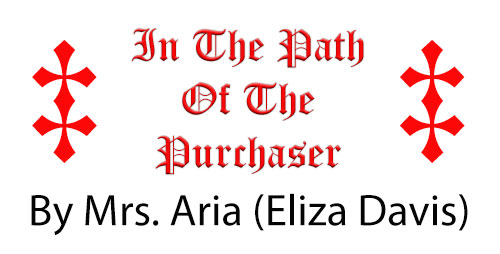
Article appearing in the 1907 Supplement to the Cunard Daily Bulletin by Mrs. Aria (Eliza Davis) offered a glimpse of the what women did to make their fashion and accessory purchases in London at the turn of the twentieth century.
In the Path of the Purchaser
By Mrs. Eliza Aira
Possibly what most impresses the woman who is a stranger to London is the exceeding diversity of its shops. Each possesses a distinct individuality of its own, and seeks rather to differ from, than to imitate its competitors.
Then, too, an added charm for her who loves variety, lies in the fact that the select West End house boasts no single feature in common with a New York store, or any place of the kind to be found in other parts of the world.
Each well-known establishment has its specialty, its pronounced characteristics, and its exclusive clientele, so that the alert society woman familiar with her modern Babylon can guess which famous decorator is responsible for the success of a certain drawing-room or boudoir, and for which celebrated Maison de modes a hat or gown emanates.
Jay's of Regent Street, London
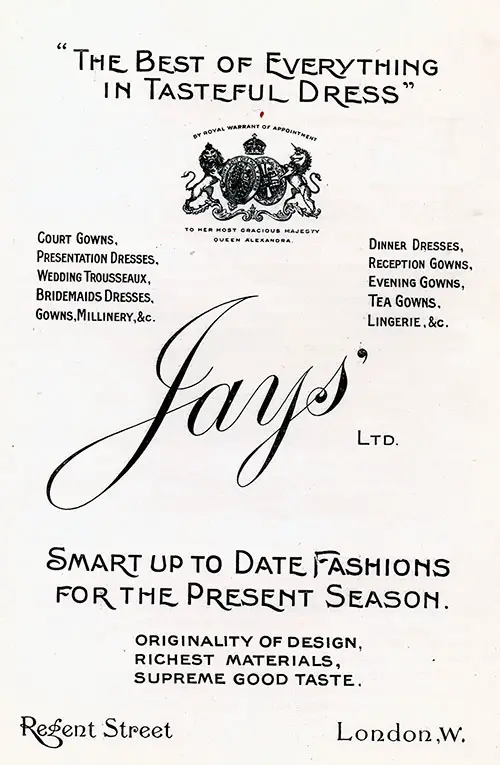
The new-comer, deficient in this essential knowledge, should set to work to familiarize herself with London's shops, a task which should prove congenial as well as instructive and profitable.
Taking as example, our Mother Eve, whose first intelligent thought was of clothes, she cannot do better than begin her education at Jay's, Regent Street, where she will find all that is newest and most exclusive in the matter of dress, from a pair of silk stockings to a Court gown.
While she is intent upon the suitable selection of a veil or parasol, she has but to turn her head to see marvelously robed damsels trailing about in frocks that range from the elegant simplicity of linen, for morning wear, and the severely tailor-made, to the subdued splendor of lace, chiffon, silk end jewels, the work of master-hands guided by an artist's eye.
Among the many creations which will pass before her she will do wisely to note an afternoon toilet of dark blue voile, finely striped with green.
The flowing skirt reaches to the bust, where it meets the slightly over-hanging corsage, which reveals a shallow rounded collar in vivid grass-green silk, with touches of crushed strawberry and blue embroidery.
Perforated gold buttons appear in front, and the deep neck band and little yoke are of white Indian embroidery, the short Japanese sleeve consisting of green silk supplemented with puffed under-sleeves of blue chiffon, banded with white embroidery.
Fascinating, too, is a gown of white foulard, conspicuous for a crisscross pattern traced faintly in black. The graceful skirt shows a double box pleat in front, and two rows of tiny black velvet loops on the hem, the essential short-waisted effect being achieved by means of a black satin belt à la Josephine, over which the bodice pouches, displaying a vest of peacock-blue linen embroidered in black, white, and flame color, and a chemisette of snowy mousseline threaded with narrow black velvet ribbon at the throat, terminating in two bows under the chin.
The coat of completion is of Lilliputian proportions and is quaintly picturesque.
Fashioned from black facecloth it is cut in one with the wide cape-like sleeves and possesses a small collar of black satin edged with peacock-blue velvet, which turns over a second and larger one of white embroidery, frilled with Valenciennes, the fronts bearing piping of satin and gold military buttons.
The crowning point is a hat of black crinoline, worn well off the face, and conspicuous for a full crown of pale blue and dull pink Pompadour ribbon, the wavy brim revealing a big pink and a big white rose at the right side.
Even though I trespass unduly upon the space at my disposal, I cannot refrain from chronicling an evening dress of black crêpe de chine, perfectly plain and tightly fitting.
An ethereal effect is lent by floating scarves of black tulle which fall from the waist before and behind and seem continuations of the bretelles of rose satin ribbon which come over the shoulders to cross at the waist, where they are held by a vest of black lace studded with diminutive beads dull jet and glittering diamonds, while the chemisette is composed of filmy masses of tulle.
Destined to be worn with it is a particularly graceful opera cloak of black lace embroidered in jet and hemmed deeply with black velvet over a foundation of pink chiffon.
Rose satin chiffon, and cream point d'Alencon inspire the hood, which is lined with black Chantilly, long ends of black lace lined with rose, and of pink satin and cream point d' Alencon falling from the throat.
International Fur Store, London
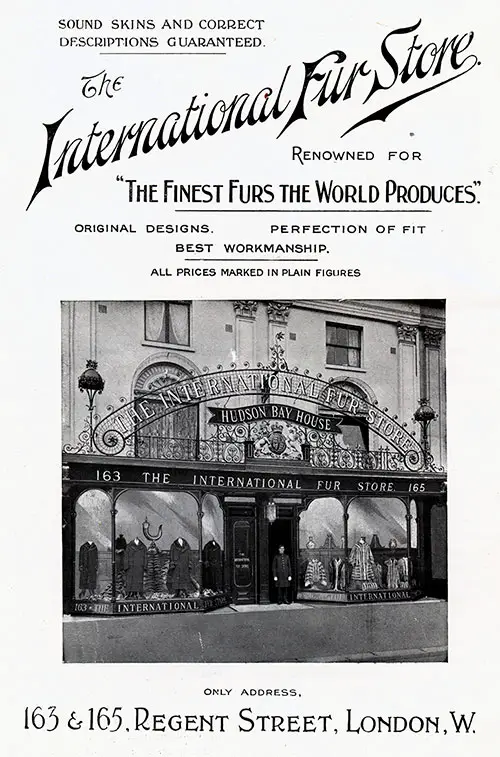
No one who has shivered in the deathly chill which precedes early dawn, can fail to realize the infinite comfort of a long, loose coat of shorn musquash, dyed a dark seal. Designed by the International Fur Store, Regent Street, and dedicated to the voyageuses, this admirable wrap is double-breasted, fastening with three giant buttons in smoked pearl, rimmed with platinum, while the deep rolled collar can be turned up at will to afford complete protection to the back of the head and ears.
Of Nutria, is a second full-length coat at once stylish and serviceable and warm. This falls in fluted pleats from the bust and displays a small collar of velvet to match, the immense buttons down the front and on the wide cuffs to the three-quarter sleeves being of raised gold embroidery and grey silk crochet surrounded by dahlia-like points in velvet.
Yet a third coat which extends to the ground is possessed of distinct attractions, evolved from superb mink in its natural color.
Russian embroidery, in characteristic shades of blue, yellow, and red, appears on the little collar and tight cuffs, the fronts opening to reveal facings of the same, while the fiche effect, in ivory point de Venice is accentuated at the bust with cut steel buckles, whence dangles a cluster of tails.
For wear with a skirt of some heavy material, nothing could be smarter than a little tightly-fitting motor coat to the hips, of grey Chinese kid. This has a square collar of the sailor order, in lightest Royal-blue velvet, heavily embroidered in raised gold with lozenges in blue, green, red, and yellow silk, which convey the impression of jewels, ladders of grey cloth running over the shoulders, more grey cloth forming the tight cuffs and the lower portion of the jacket, which stands out from the figure in the approved fashion of the moment.
Further features of importance are the oxidized silver buttons down the fronts and on the sleeves, and the short-fringed ends of vivid-blue satin, which fall from the collar at either side of the bust.
Jaeger's on Regent Street
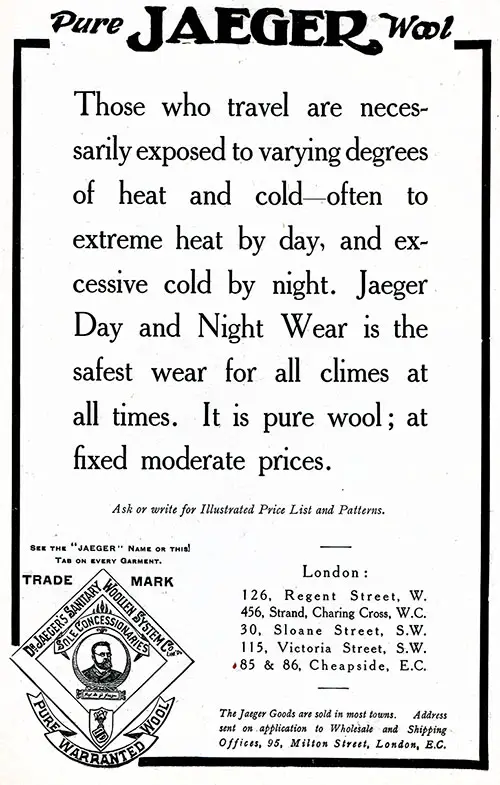
Being on the subject of travelling, it may be as well to make mention of certain specialties to be found at Jaeger's, 126, Regent Street. Prominent among these are the fleecy wool jerseys brought out this season.
The latest model is most becoming and does not take up much room. Double-breasted, it displays large leather buttons and a deep collar, so contrived that it can be worn high, low, or turned up to protect the ears if desired, small buttons holding it in the wished-for position.
The blouse fits tightly and the fluted basque comes well down below the hips.
Another fashionable style of jersey is the Norfolk, which appears in white, black, self-colors, and all the accredited tartans so dear to the hearts of those of Scotch descent.
These last are accompanied by plain cloth, serge, or heather-mixture skirts, the seams defined by lines of knitted tartan. It is not incumbent to buy both skirt and jersey, but it is a distinct convenience to be able to do so, the combination resulting in a complete and very fetching costume when finished with a Tam o' Shanter, stuck through with an eagle's quill, and further adorned with a cairngorm.
For more dressy occasions pretty crossover blouses commend themselves in fine white woolen material, the yoke, neck-band, and cuffs embroidered in colored silks and gold thread, all of these being capable of being washed.
To the woman of ample proportions, a stay recently designed by Jaeger must make eloquent appeal. Fashioned from fine and very strong woven texture, the corset in question is made in one with the knickerbockers and vaunts a row of small buttons below the hips, for the attachment of a petticoat of similar material provided with a removal silk flounce.
The corset is so contrived that the busk and bones can be drawn out to allow of the necessary visit to the laundress and replaced with the minimum of labor.
The durability of a stay of this kind, from the hygienic point of view is too self-evident to call for comment, hence the popularity it instantly secured.
No one who has travelled needs to be convinced of the absolute need of Jaeger underclothing and night garments, while all sufferers from rheumatic affections of any kind whatsoever, should on no account fail to provide themselves with Jaeger sleeping bags, originally planned for hunters, explorers, and all those who venture outside the beaten track into regions where hotels are not, and chills and fever are.
Peter Robinson of Oxford Street
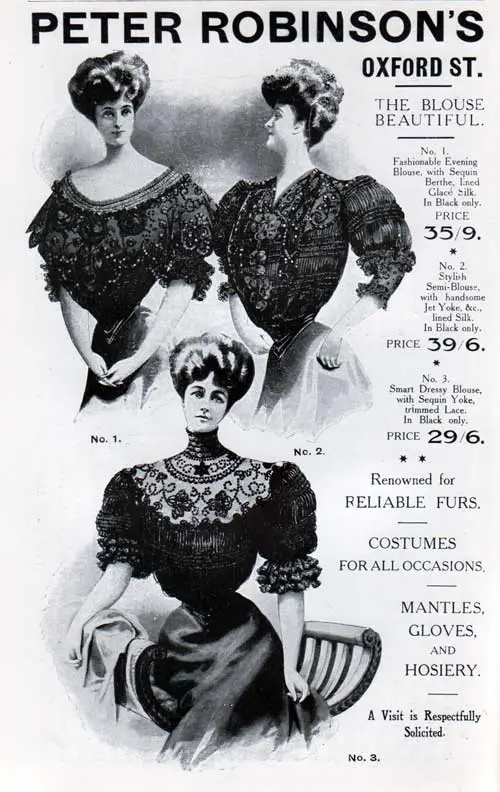
No matter how skillfully packed it may have been, one's clothing has an exasperating trick of emerging from the best and most capacious of trunks with a thousand creases, and the dejected droop of the " 'and-me-down " of pawnbroking fame.
In this emergency, it is comforting to know that Peter Robinson, of Oxford Street, makes a special feature of ready-made costumes of all descriptions.
Stylish in design and well cut are coats and skirts of diverse colors, fashions, and materials, for three guineas, a variety of better frocks in evidence here at prices which are quite as low in proportion.
The woman so fortunate as to be unhampered by the sordid conditions of pounds, shillings, and pence, will delight in the host of beautiful model gowns, cloaks, hats, and tailor-made costumes on view in the vast show rooms.
Where so much is desirable, it is difficult to particularize, but mention must be made of an afternoon frock of cream marquisette.
Genre Empire, this boasts a yoke of Irish crochet, from which narrow lines of cream Mechin insertion run down as far as the knees in front, growing gradually less as they near the back, while on them are embroidered green silk spots which shade to darkest emerald at the waist, and fade to palest lettuce at the extremities.
The short bodice pouches over a swathed belt of green satin, an effective touch being lent by a huge steel buckle at the left side, where it holds a big rose of the fashionable tint known as Rembrandt pink, Vandykes of Irish crochet appearing on the hem.
The accompanying wrap is at once suggestive of a cape and as a fichu, and is of emerald-hued taffeta, trimmed with oval motifs of cream satin on which baskets of roses are painted by hand, the long ends, which fall nearly to the feet in front, finishing in metal ornaments.
For travelling and all occasions which demand the severely tailor-made, nothing could be smarter than a costume in a broken black and white check, crossed and re-crossed in large squares by lines of violet the tightly-fitting jacket reaches to within a few inches of the hem of the plain skirt and vaunts a collar and cuffs of violet velvet, the revers being piped with purple cloth and a fine edging of the same running down the front which fastens with three violet buttons at the waist.
The Parisian Hat Company
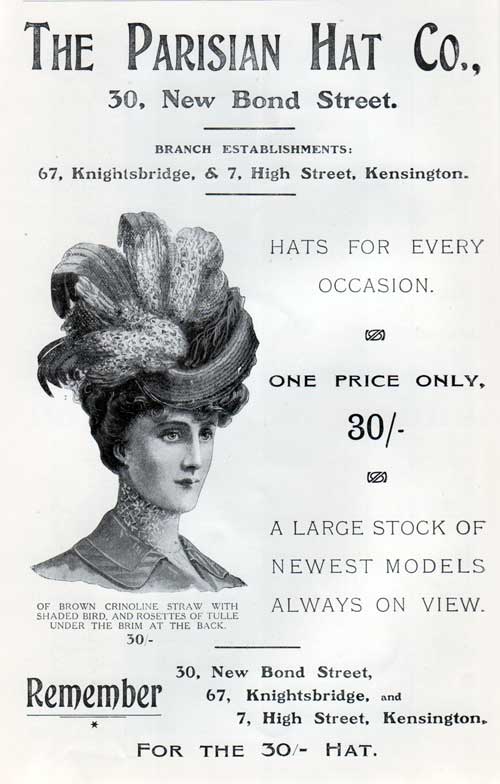
A noticeable feature of the modes of the moment is that whereas the average woman used formerly to content herself with one hat for best and two and perhaps a toque for every day wear, she now has her ten or twelve.
There can be little doubt but that the Parisian Hat Company, of 30, New Bond Street, 67, Knightsbridge, and 7, High Street, Kensington, is largely responsible for the changed condition of things.
The explanation lies in the fact that at these most fascinating establishments a uniform price of 30s. is charged, so that the purchaser harbors no misgivings lest she may be tempted into spending more than she had originally intended.
She knows, too, that she will not cast covetous eyes upon a beautiful model and be obliged to relinquish it in favor of one at fourth the price, a sacrifice which will leave her with a smoldering resentment against hats in general and her own in particular.
Another advantage at the Parisian Hat Company, is that the needs of the matrons are considered quite as much as are those of the maid, while the styles represented embrace all that is newest in the world of fashions from the simple toques dedicated to the services of the tailor-made and the motor, to the dainty elaboration of the chapeau suitable for wear in a carriage in the park between the sacred hours of four and six, when Queen Alexandra is wont to take her afternoon drive.
Appropriate to such distinguished circumstances is a little hat of a new and indescribable shape, contrived from shot lavender straw, wreathed with forget-me-nots and their foliage, a natural ostrich feather curling over the brim to caress the left cheek, and masses of fluffy brown tulle composing the cache-peigne and draping the all-round bandeau.
An altogether delightful toque, designed to be worn at a coquettish angle slanting from right to left and resting on a hank of curls, appears in a vivid tone of Royal-blue crinoline, a big green, blue and chestnut-colored bird trimming the front with excellent effect.
The newest sailor hat is present in Swiss blue straw, the high crown banded with blue velvet tied in an imposing bow at the left side and edged top and bottom, with a quilling of point d'esprit in a deeper tone, a mass of La France roses filling up the gap between hair and brim at the back.
Savoy Tailors' Guild
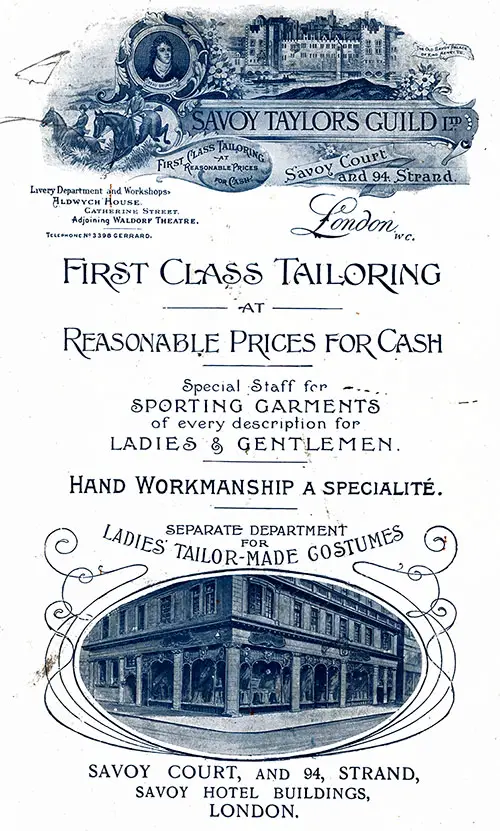
The woman who has made an intelligent study of the art sartorial knows that it is good policy to go for her tailor-made garments to a good firm, such, for example, as the Savoy Tailors' Guild, Savoy Court, and 94, Strand, W.C.
None but masculine hands can insure those straight lines, seams ruled with mathematical precision, and exquisite neatness of finish essential to the success of a costume of the kind.
There is a total lack of that trimming with which a dressmaker makes good any deficiencies in cut and style, and only a tailor seems able to command the square set of the shoulders and trim expression of waist which are essential to success.
Another question of importance is the material employed. The cloths and tweeds of the man tailor are rarely to be found at the dressmakers. The reason for this is not far to look for as the stouter textures demand infinitely greater skill and accuracy in their proper manipulation.
Among the specialties of the Savoy Tailors' Guild are motor and travelling coats and costumes, and all such garments which need to be well cut and of materials sufficiently strong to stand the stress of wear and tear.
In a costume made by this noted firm a woman may safely embark on a tour round the world, happy in the knowledge that she will appear to advantage under the most trying circumstances and arrive neat and taut at her journey's end.
How this desirable result is achieved can best be learnt by a personal visit to this firm where, by the way, all that is most up-to-date in the matter of masculine attire can be investigated at the same time.
John Wilson's Successors
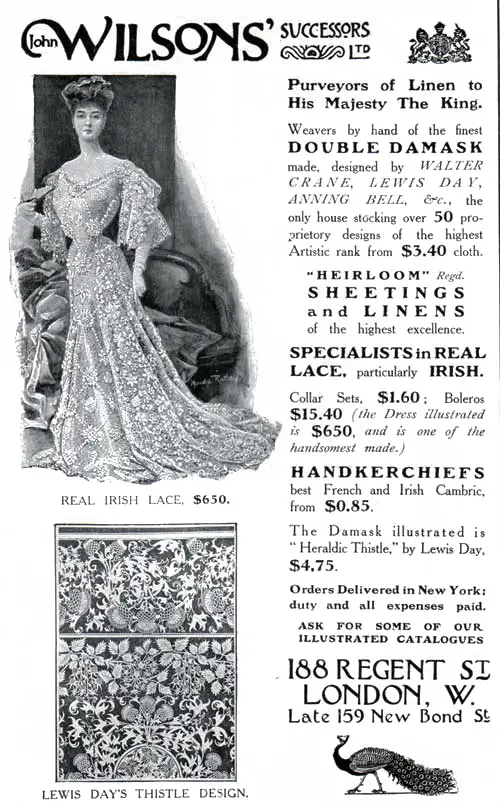
Any doubts as to the continued popularity of lace and hand embroidery are silenced at John Wilson's Successors, 188, Regent Street, where the demand for both exceeds that of former years, and threatens to become even greater as the season advances.
Just now fashion is smiling her brightest upon Princess robes of Irish crochet in incredibly beautiful and effective designs at forty guineas.
Another feature of this well-known house long associated with the dainty work of Hibernia's fair daughters, are skirts of Irish crochet, accompanied by a bolero or cape to match, for thirty-six guineas.
A gown of this sort is easily completed by a blouse of snowy chiffon further glorified by a yoke of Venetian point or Valenciennes inserted with medallions of fine Irish crochet and finished with touches of gold or silver braid.
Such a dress is a thing of beauty and a joy forever, the lace being so strong that it is practically impossible for it to wear out, while age but enhances its charm and adds to its value.
Besides their vast assortment of all sorts of berthas, opera cloaks, collars, handkerchiefs, scarves, and fans in Irish crochet, Limerick point and Carrickmacross, Messrs. John Wilson's Successors are famous for their modern and antique Italian, Spanish and Brussels lace.
Some especially lovely bridal veils call for mention, as well as certain flounces suitable for Court, evening and wedding gowns.
The revival of the high comb of carved tortoiseshell, among the few who lead the way in paths fashionable, has induced consideration for the Spanish mantle and the lace square as pre-eminently becoming to silver hair as to golden curls.
Besides lace of all descriptions and in every known form, John Wilson's Successors are celebrated by reason of their Irish linen and satin damasks, all of which are hand-woven in Lurgan, the firm making the unique boast that every design is original and exclusive to itself.
To this end were employed such eminent artists as Walter Crane, Sir John Millais, and others of equal note, the result being table cloths and napkins of quite exceptional beauty.
From linen to furniture is a natural transition, one seeming to suggest the other as a matter of course.
At the present moment there is a most praiseworthy boom in house decoration, and many a Grande dame has decided to do with half a dozen or so less frocks, and make shift with one motor instead of two, as well as the making of numerous other sacrifices of an equally self-denying character, in order hat her drawing room may be done up in English Eighteenth Century style, her boudoir be converted into a classical chamber of the Empire period, and her dining-room recall the days when Roundhead and Cavalier contested Merry England.
Waring & Gillow
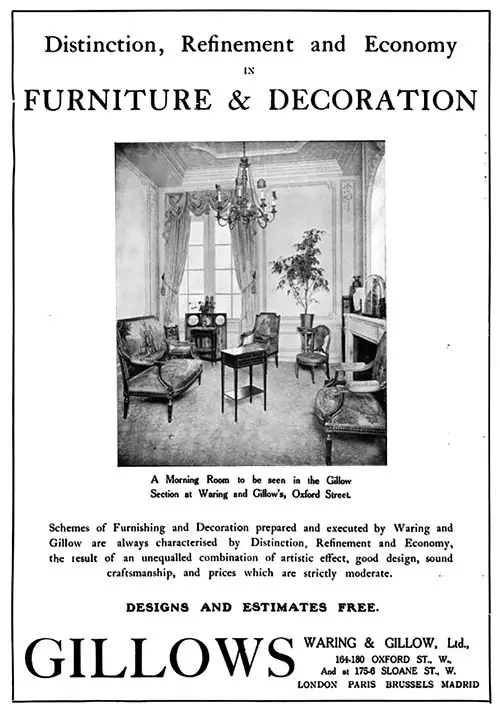
Such being the case, house decoration has received an immense stimulus, the various great firms vying with one another in their efforts to achieve distinction.
On this account alone, no visitor to London should fail to go over the vast premises recently opened by Waring & Gillow, in Oxford Street.
These go by the name of the New Galleries and should prove doubly interesting to such Americans as imagine the British to be lacking in enterprise and the ability to organize on a grandiose style.
The big block of red brick buildings in question is situated within four minutes of Oxford Circus, and contains practically everything known to the modern cabinet maker's art.
Most attractive features are seven complete houses, ranging from a five-roomed country cottage to a comfortable mansion of the thoroughly comfortable type, decorated and furnished throughout at prices which rise from £100 up to £750.
The figures quoted include bedding, linen, hardware, china, and cutlery, and any one personally acquainted with the cost of furnishing and decorating, is impressed by the fact that the purchaser is not only saved a vast amount of work, worry and thought, but gets exceedingly good value for his money as well.
Everyone is free to wander through the galleries, inspecting the treasures in tapestries statuary, porcelain, silver, plated ware, bric-a-brac, curtains, carpets and furniture representative of many countries and periods.
The collection possesses all the interest of a museum with the added charm that one can become the owner of anything that appeals to the fancy.
Having exhausted the modern, the lover of antiques should wend his way across the road to Waring & Gillow's other premises, at 176 to 181, Oxford Street, where objets d'art will keep him a willing captive, and he will find much that is beautiful and rare in early English, Italian and French furniture, including some fine specimens of armor and several unique marble mantel-pieces.
Walpole's of London
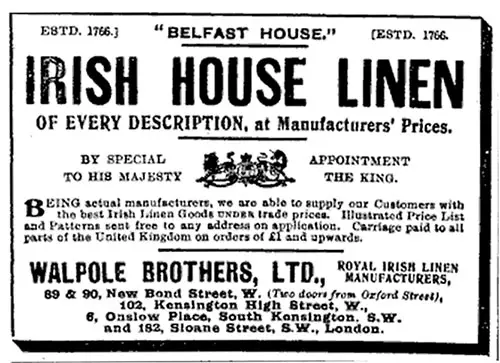
The woman who loves linen, and no woman worthy the name does not, will find excellent excuse for breaking the Tenth Commandment at Walpole's, 89, New Bond Street, the famous Irish firm, which supplies the Royal household, and is specially appointed to King Edward VII.
Everything emanating from this well-known house is of guaranteed quality and exceptional excellence of design, the product of its own hand looms. Of finest linen are sheets, exquisitely embroidered, hem-stitched, lace inserted and threaded with white satin ribbon, the accompanying pillow slips, counterpanes, nightgown sachets, and toilet strips being marvels of exquisite needlework.
Table cloths of satin damask, napkins, and lace d'oyleys are present in endless variety of design, some of the most effective boasting a woven monogram, coronet, or crest in the center.
The most alluring of pincushions appear from 3s. 6d. upwards. These are made in pale colors and have detachable coverings of white muslin, hand-embroidered, edged with lace-bordered and hem-stitched frills, further elaborations taking the form of butterfly bows in satin ribbon.
Of handkerchiefs the assortment is practically inexhaustible. Some in silver flax, clear and exceptionally soft, are 3s. 11d. the dozen, glove size, while large handkerchiefs, of hem-stitched Irish cambric are only 2s. 10d. the dozen.
Then there are embroidered handkerchiefs and lace-edged handkerchiefs of the daintiest description and sets of collars and cuffs which pay eloquent tribute to the needle's skill.
Another specialty of the firm is its Irish crochet, and particular mention must likewise be made of its embroidered blouses, plain dress linens in white and colors, the lace curtains and printed table covers and bed-spreads, all of which are of the best British manufacture.
The visitor to London who is prevented from calling personally at 89, New Bond Street, should make a point of writing for one of Walpole's copiously illustrated catalogues. A glance down its pages is both instructive and inspiring, while the prices quoted will give the housekeeper seriously to think.
Irish Warehouse
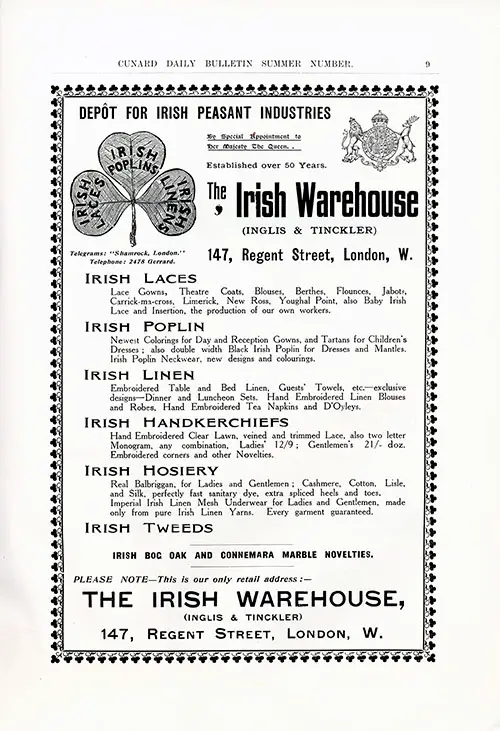
No peasants in the world, not even those of Tenerife, can equal the Irish the moment it is a question of linen embroidery, while their reputation as lace makers is an equally high one.
To realize thoroughly how exquisite and varied is their work demands a visit to Inglis and Tinckler's Irish Warehouse, 147, Regent Street.
Specialties of the establishment are poplins, dress linens, Balbriggan hosiery, homespun, handkerchiefs, lace, and every kind of household linen from the plainest to the most ornate.
Under the last category come d'oyleys, table centers and plate and dish mats trimmed with either crochet or Irish point, the latter so fine and of such beauty that it needs to be examined under a magnifying glass for the infinitesimal stitches to be appreciated or even realized.
Table cloths are present in every size, from a yard square, and in an immense variety of designs, some of them being of silk and linen damask, the result a satin-like surface of great brilliancy.
Bedspreads, pillows and sheets and handkerchiefs are embroidered in such a way as to make them veritable objects of art, while the little white cushion from which no Frenchwoman with any claim to elegant refinement would consent to be parted, appears in a hundred different shapes and patterns from 7s. 6d.
The latest fashion in handkerchiefs takes the alluring form of a diminutive square of snowy fabric, so fine as to be transparent. The hem is an eighth of an inch in depth, and the design a woven check, likewise in white. Handkerchiefs of this kind begin at 5s. 11d. the dozen and mount to thirty guineas.
Needless to state that at the latter figure they are entirely hand-made, no machine having ever touched them. It is rather surprising that there should be a demand for these plain cambric handkerchiefs at thirty guineas a dozen, but in the season the fastidious lady of fashion, who will have the best and finest of everything, pays the price willingly, and feels that she is receiving good value for her money.
The same handkerchiefs exactly, only in appropriate sizes, are supplied for gentlemen. While the Irish work well, they also work cheaply, as is proven by hand-embroidered linen robes from 21s. to £35 and crochet boleros from £3.
Bert & Co.'s, London
Virtuosos, and all lovers of the beautiful and antique, will find much to charm them amid the treasures of jewelry, old silver and Sheffield plate, at Bert & Co.'s, 3, Vigo Street, Regent Street.
Commencing with the first on the category, special interest attaches to a necklace composed of a single row of graduated pearls, of such perfection that they took six months to collect, with a clasp of a simple catch set with three brilliants, and a price of £2,000.
No woman with auburn hair could resist the seduction of a necklace which displays four large peridots and a yellow topaz set in gold and is fastened round the throat by a slender platinum chain; while nothing more becoming could be desired than a flat eighteenth century collar fashioned from chains of lustrous pearls strung on horse-hair.
At the moment the great demand is unmistakably for emeralds, and a particularly large assortment of these is to be found at 3. Vigo Street, set as hair ornaments, pendants, rings, brooches, and necklaces.
Passing to old silver, a valuable William M. tankard of characteristic design displays the date letter 1701 and the hall mark prominently and in plain figures on the brim. Another fascinating example consists of an Irish sugar basket dated the year of the Great Rebellion.
A hot-water jug in antique Sheffield plate appeals by reason of the highly ornate decoration of the lid, which reveals a strawberry surrounded by wonderfully wrought leaves; and yet another treasure trove is a fifteenth century casket of Italian workmanship, formerly in the possession of a princely house.
Of wrought brass, the side panels bear the figures of the "Magi" in bold relief, and the lid is studded with various precious stones.
Alike, the frivolous woman of fashion with a passion for the beautiful and unique in jewelry, and the seriously-minded virtuoso, will meet on common ground at 3, Vigo Street, where they might pause a moment and honor the contemporary as shown in photo of the famous challenge cup, presented to the Royal Yacht Squadron by King Edward and designed by Bert & Co., and in the drawing by Princess Beatrice (Mother to the Queen of Spain) of the bracelet presented to Queen Victoria on her first jubilee, and which was held to be her late Majesty's favorite piece of jewelry of the kind.
Davis, Eliza (Mrs. Aria), "In the Path of the Purchaser," in The Cunard Daily Bulletin: Fashion & Pleasure Resort Supplement, Liverpool: Cunard Line Steam Ship Co. Ltd., 1907. Article supplemented by advertisements from vendors discussed in the article.
Editor's Note: Some terminology used in the description of women's clothing during the 1800s and early 1900s has been changed to reflect more modern terms. For example, a women's "Toilette" -- a form of costume or outfit has an entirely different common meaning in the 21st century. Typical terms applied to "toilette" include outfit, ensemble, or costume, depending on context.
Note: We have edited this text to correct grammatical errors and improve word choice to clarify the article for today’s readers. Changes made are typically minor, and we often left passive text “as is.” Those who need to quote the article directly should verify any changes by reviewing the original material.
Vintage Fashion Trends
GG Archives
Vintage Fashion Trends Topics
- A Day of Dress Fashions in New York with Miss Gould - 1912
- Bonnets During Queen Victoria's Reign
- Embroidery in Spring Fashions - 1911
- Fashion Forecast for The Spring Season 1912
- Flirtatious Fashions for Women - April 1919
- Garment Fashions for Spring 1915
- Spring Clothing Fashions 1915
- Spring & Summer Original Designs by Lady Duff-Gordon - 1917
- London Fashions January 1885
- London Fashions February 1885
- London Fashions March 1885
- London Fashions April 1885
- London Fashions May 1885
- London Fashions June 1885
- London Fashions November 1887
- London Fashions December 1887
- London Fashions January 1888
- London Fashions February 1888
- London Fashions March 1888
- London Fashions April 1888
- London Fashions May 1888
- London Fashions June 1888
- London Fashions July 1888
- London Fashions August 1888
- London Fashions September 1888
- London Fashions October 1888
- London Fashions November 1900
- London Fashions September 1902
- London Fashions June 1903
- London Fashions July 1903
- London Fashions August 1903
- London Fashions October 1903
- London Fashions November 1903
- London Fashions February 1904
- New York Fashions February 1904
- Paris Dress Fashions and Gossip November 1900
- Paris Dress Fashions and Gossip September 1902
- Paris Dress Fashions and Gossip July 1903
- Paris Dress Fashions and Gossip August 1903
- Paris Dress Fashions and Gossip October 1903
- Paris Dress Fashions and Gossip November 1903
- Paris Dress Fashions and Gossip December 1903
- Paris Dress Fashions and Gossip February 1904
- Paris Dressmakers 1921 Fall Offerings
- Paris Fashions November 1887
- Paris Fashions December 1887
- Paris Fashions January 1888
- Paris Fashions February 1888
- Paris Fashions March 1888
- Paris Fashions April 1888
- Paris Fashions May 1888
- Paris Fashions June 1888
- Paris Fashions July 1888
- Paris Fashions August 1888
- Paris Fashions September 1888
- Paris Fashions October 1888
- Paris Fashions November 1909
- London & Paris Fashions May 1906
- London & Paris Fashions June 1906
- New York Fashions February 1904
- Shopping for Fashions & Accessories 1906
- Shopping for Fashions & Accessories 1907
- Shopping for Fashions & Accessories 1908
- Shopping for Fashions & Accessories 1912
- Today's Fashions October 1900
- Today's Fashions November 1900
- Today's Fashions September 1902
- Today's Fashions June 1903
- Today's Fashions July 1903
- Today's Fashions October 1903
- Today's Fashions November 1903
- Today's Fashions December 1903
- Vanguard of Fashion 1912
- Wedding Presents, Past and Present
- World of Dress Fashions 1906
- World of Dress Fashions 1907
- World of Dress Fashions 1908
- Fall Clothing Styles Summary 1922
- Made in U.S.A. Movement 1915
- Silk Fabrics in Fashion 1916
- The Importance of Dress March 1919
Women's Vintage Fashion Topics
- Activewear
- Bathing Suits
- Blouses
- Clothing Accessories
- Dresses
- Evening Gowns
- Funeral Attire
- Hats & Headwear
- Lace and Linen
- Lingerie
- Loungewear
- Maternity Clothes
- Outerwear
- Skirts
- Tailored Suits
- Travel Outfits
- Vintage Fashion Houses & Designers
- Vintage Wedding Fashions, Weddings, and Anniversaries
Other Vintage Fashion Topics
- Vintage Fashion Advertisements
- Vintage Children's Fashions
- Folk Costumes
- Fashion Trends
- Vintage Men's Fashions
- Vintage Teen Fashions
- Vintage Women's Clothes
Improve Your Family History Through Illustrations

